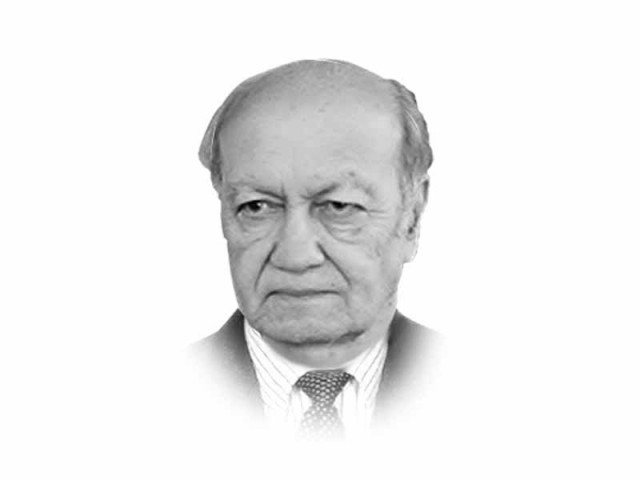Harmonising state policies with economic pragmatism
With narrow economic base, heavy dependence on foreign assistance, Pakistan has to be prudent in resource mobilisation

The writer is a retired lieutenant general of the Pakistan Army and a former federal secretary. He has also served as chairman of the Pakistan Ordnance Factories Board
The defence budget is a one-line demand for grants submitted by the Defence Division for the three services and defence production. The complex nature of current threats and challenges that Pakistan faces demand a more rigorous scrutiny and sophisticated approach in the allocation of resources to the defence and security sectors. Hopefully, this coming session the Standing Committee of the National Assembly on Defence would play a more active role in the formulation process and contribute by providing valuable suggestions.
The Indian defence budget has been growing every year as India’s economy and aspirations of its leaders to assume the mantle of a regional and global power keep rising. The mountainous border prevents India from being threatened from the north by China, yet it uses the threat by China as a basis for boosting its defence spending each year. India’s maritime activity in the Indian Ocean is expanding beyond its littoral region. It is aiming for a full-fledged blue water navy and the planned acquisition of advanced naval warships and nuclear-powered submarines is part of this strategy. Besides, it wants greater presence near Sri Lanka and is likely to expand its fleet to counter Chinese presence in Gwadar.
Pakistan’s gravest threat, however, as both General Kayani and General Sharif have stated, emanates from within and has to be accorded the highest priority. The nature of the internal threat demands a different strategy to succeed. In addition to maintaining a highly professional and well-equipped counterinsurgency force, similar priority should be accorded to the economic uplift of the masses. Proper allocation of resources for education, health and infrastructure are critical criteria for achieving peace and stability. The Balochistan insurgency, militancy and extremism in Fata and the fight against terrorist hideouts in Karachi demand a comprehensive approach as spelled out in the National Action Plan, which envisages administrative measures and improved governance. Application of force alone, however, will not rid our country of militancy and extremism. The Rangers have been engaged in Karachi for the last 27 years, while formal deployment of the army in Fata took place in 2002 and it has also been directly and indirectly involved in countering the low-level insurgency in Balochistan since 2004. The situation in all these places remains volatile and fluid. This clearly indicates that the use of force does have a limited value and has to be accompanied by other measures to succeed. Insurgency and terrorism should not be viewed exclusively through the security prism. Budget distribution should reflect this broader understanding of the challenge. The insurgency has to be dealt through economic uplift and political engagement with dissidents, besides also being dealt with militarily. While the role of the Standing Committee on Defence is recommendatory in nature and the Ministry of Defence (MoD) is largely autonomous, better coordination between the MoD and parliament will strengthen the budget process.
The two most recent horrific incidents of terrorism — the brutal killing of the Ismailis in Karachi and Pakhtuns in Mastung — indicate the multiple fault lines that have developed in Pakistan over the years. What is worse is that the state appears helpless in doing anything substantive apart from pointing fingers at RAW. The basic question we need to ask ourselves is how is it that some segments of our society have become so inimical to the state so as to be willingly manipulated by the Indians. They are perhaps, so bitter for some genuine or misconceived reasons with the ruling structure of Pakistan that they have rebelled against it. India takes advantage of these groups and has intensified and expanded its intelligence war against Pakistan. The Indian security establishment also exploits Pakistan’s vulnerabilities as a soft state. Iran and some Gulf States are also seeing the development of the Pakistan-China corridor as a potential threat to their economic and strategic interests. This factor further emboldens New Delhi to take a more aggressive posture in creating unrest in Balochistan and in the ungoverned parts of Fata. India, too, has its vulnerabilities. Jammu and Kashmir is India’s most sensitive and volatile state. It is keeping the lid on the discontent by employing a massive security force, which its economy can afford.
The trajectory of policies that India and Pakistan are currently pursuing will only heighten tensions and could lead to unintended consequences. Prudence demands that both take a pause and revisit their policies. Internally, Pakistan should intensify its efforts at finding a peaceful solution with the Baloch dissidents. Only focusing on military operations and talking of a Karachi type of operation could aggravate matters unless the reference is to take action against the Lashkar-e-Jhanghvi and Jundullah. With New Delhi, Islamabad should raise the issue of the former’s support to the BLA and other dissident groups. And Pakistan should heed the concerns of the disaffected segments of our society.
It is also important that India and Pakistan engage bilaterally on the terrorism issue. For both countries, this is a central issue and they cannot indefinitely keep avoiding dealing with it bilaterally. India might have adopted asymmetric warfare as its current policy to use coercive power against Pakistan, but there is always the danger that this could lead to conventional and higher stages of conflict. This has been the historical experience of the two countries in 1965 and 1971. And if any side feels that the nuclear umbrella allows greater freedom to operate at the sub-conventional level, then Kargil is a glaring example of this idea’s failure.
Pakistan, with a narrow economic base and heavy dependence on foreign assistance, has to be more prudent in the mobilisation, allocation and expenditure of resources. This should be combined with a foreign policy that aims to bring about a peaceful neighbourhood for economic development and political stability.
Published in The Express Tribune, June 3rd, 2015.
Like Opinion & Editorial on Facebook, follow @ETOpEd on Twitter to receive all updates on all our daily pieces.


















COMMENTS
Comments are moderated and generally will be posted if they are on-topic and not abusive.
For more information, please see our Comments FAQ